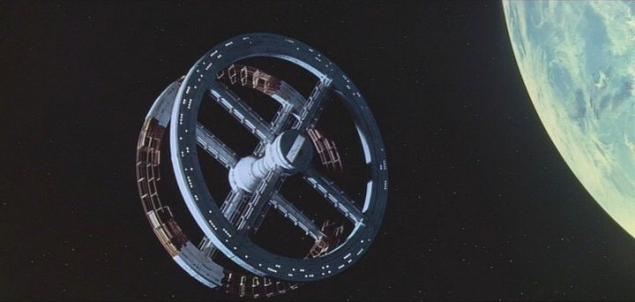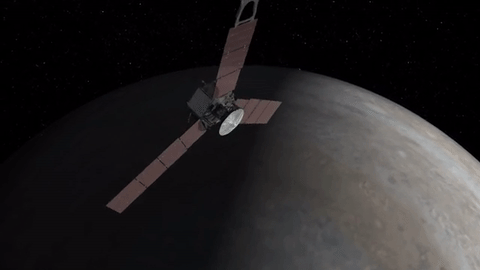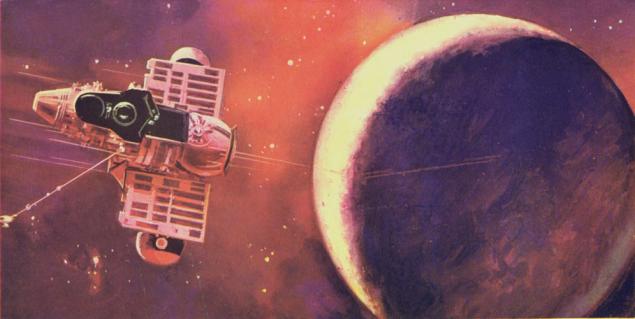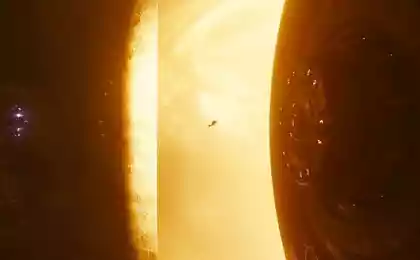756
Why spacecraft orbit
To rotate objects are in space - it familiar. When the two masses are moving relative to each other, but not toward or away from each other, their gravitational force creates a torque. As a result, the solar system, all planets revolve around the sun.
But this is something that a person is not affected. Why rotate the spacecraft? To stabilize the situation, constantly guide devices in the right direction and in the future - to create artificial gravity. Let's look at these issues more.

Stabilization vrascheniemKogda we look at the car, we know in which direction he was going. it is controlled by the interaction with the environment - adhesion to the road wheels. Where the wheels are turning - back and the whole car. But if we deprive him of this clutch, if we send the car on bald tires to skate on the ice, it will begin to spin in the waltz, which is extremely dangerous for the driver. This type of motion is rare on Earth, but in space is the norm.
BV Rauschenbach, academic and Lenin Prize winner, wrote in "motion control spacecraft" for three major types of motion control tasks spacecraft:
But this is something that a person is not affected. Why rotate the spacecraft? To stabilize the situation, constantly guide devices in the right direction and in the future - to create artificial gravity. Let's look at these issues more.

Stabilization vrascheniemKogda we look at the car, we know in which direction he was going. it is controlled by the interaction with the environment - adhesion to the road wheels. Where the wheels are turning - back and the whole car. But if we deprive him of this clutch, if we send the car on bald tires to skate on the ice, it will begin to spin in the waltz, which is extremely dangerous for the driver. This type of motion is rare on Earth, but in space is the norm.
BV Rauschenbach, academic and Lenin Prize winner, wrote in "motion control spacecraft" for three major types of motion control tasks spacecraft:
- Get the right path (the center of mass motion control), < /
- orientation of management, ie the production of the desired position of the body of the spacecraft relative to external benchmarks (control rotational movement around the center of mass);
- the case where the two types of control are implemented at the same time (for example, when approaching spacecraft). The rotation of the device is carried out in order to ensure a stable position of the spacecraft. This experiment demonstrates in the video below. The wheel, fixed on a rope, take a position parallel to the floor. But if it is a pre-wheel roll out - it will retain its upright position. And this will not interfere with gravity. And even dvuhkilogrammovy the goods designated on the second end of the axle, not much change the picture.
An example of this rotation leads Robert Frost, and instructor operator at NASA: an automatic interplanetary station "Juno", which was launched in 2011 to study Jupiter and released to orbit the planet July 5, 2016. Rotation - one way orientation and stabilization, which is a major advantage of economy. It should roll out the device once and can then be twisted by centuries, without using too much fuel and not caring about the device management electronically. If the electronics unit fails - "Juno" will maintain the rotation
.
Saving direction priborovPo videos difficult to see, but international space station is constantly rotated Y-axis at a rate of 4 degrees per minute. Such an angular velocity selected to synchronize stations rotation around its axis with its rotation around the Earth. Antennas look GPS-satellites and communication satellites, and from the windows of the observation of the Earth, it is desirable to see the planet in order to remove it. The rotation and acceleration are also used in order to avoid collisions with space debris.
Some spacecraft rotation used for thermal control, so as not to overheat the same direction, which could lead to failure. The International Space Station does that, unlike other devices, which are heated evenly.
In the video below you can see how the station retains its orientation relative to the Earth.
In interplanetary flight to the fore the torques generated by the pressure of sunlight, and that pressure can help to maintain the correct orientation of the device. Spacecraft "Venus" and "Mars" using the following scheme orientation: after the machine control system gave the desired position relative to the sun, the body reported to the rotation around its own axis. Then its movement around the center of mass occurred under the influence of two effects: the effect of the gyroscope and the torque generated by the pressure of sunlight. The device acquires the properties of a weather vane. This complex scheme of reaching the constant direction of solar panels to the sun.

spacecraft "Venera 3»
Creating artificial gravitatsii
concept Nautilus-X.
Adapted to life in the Earth's gravity and the body manages to survive without him. And not only survive, but also to work actively. But it costs a little miracle is not without consequences. The experience gained over decades of human flight into space, has shown that a person experiences in space a lot of loads that leave a mark on the body and psyche
. On Earth, our body is struggling with gravity, which pulls blood downward. In space etoa struggle continues, but the force of gravity is absent. Therefore astronauts puffy. Intracranial pressure is growing, growing pressure on the eyes. This deforms the optic nerve and affects the shape of the eyeballs. Reduced plasma in the blood, and because of the reduction of the amount of blood that you need to download, atrophy of the heart muscles. Defective bone mass is significant, the bones become fragile.
In order to overcome these effects, people in orbit are forced to engage in physical training every day. Therefore, the creation of artificial gravity is considered desirable for long-term space travel. This technology is to create a physiologically natural conditions for human habitation on board the vehicle. More Konstantin Tsiolkovsky believed that the artificial gravity will help to solve many health problems of manned flight into space.

The idea is based on the principle of the equivalence of gravity and inertia forces, which states: "The forces of the gravitational interaction is proportional to the gravitational mass of the body, the forces of inertia is proportional to the inertial mass of the body. If the inertial and gravitational masses are equal, it is impossible to distinguish what force acts on this rather small body - gravity or inertia »
. In this technology has drawbacks. In the case of short-range device varies the force will act on the legs and on the head - the farther from the center of rotation, the more artificial gravity. The second problem - the Coriolis force, because of the impact which the person will be rocking with the movement relative to the direction of rotation. To avoid this, the machine must be enormous. The third important issue is related to the complexity of the design and build such a device. When you create such a mechanism, it is important to consider how to enable a permanent access to the crew compartment with artificial gravity and how to make this torus move smoothly.
In real life, this kind of technology for building the spacecraft is not used. For ISS offered an inflatable module with artificial gravity for the demonstration of the prototype ship Nautilus-X. But roads module, and would create significant vibration. Do all of the ISS with artificial gravity difficult to implement with the current missiles - would have to collect all the parts on orbit for that at times would complicate the scope of operations. And yet this artificial gravity would have negated the very essence of the ISS as a flying microgravity laboratory.

Concept inflatable module for the ISS microgravity.
But artificial gravity lives in the imagination of science fiction writers. Ship "Hermes" from the film "Martian" is at the center of a rotating torus that creates artificial gravity for the crew to improve the condition and reduce the effects of weightlessness on the body.

National Aerospace Agency of the USA has developed a scale levels TRL technology readiness of nine levels: first through sixth - developed in the framework of research projects, with the seventh and higher - development work and demonstration of technologies working. Technology from the film "Martian" corresponds to is only the third or fourth level.
In science fiction literature and films have many applications of this idea. In a series of novels by Arthur C. Clarke's "Space Odyssey" describes the «Discovery One» in the form of dumbbells, whose meaning - to separate the nuclear reactor with the engine from the living area. Equator of the sphere contains a "carousel" 11 meters in diameter, rotating at about five revolutions per minute. This centrifuge creates a level of gravity equal to the moon, which should prevent the physical atrophy in microgravity.

«Discovery One» of the «Space Odyssey»
The Planetes anime series Space Station ISPV-7 has a huge space with the usual earth gravity. The living area and an area for crop production are located in the two tori, rotating in different directions.

Even solid fantasy ignores the enormous cost of such a decision. Enthusiasts take for example the ship "Elysium" from the same film. Wheel diameter - 16 kilometers. Weight - about one million tons. Sending cargo into orbit costs $ 2,700 per kilogram, SpaceX Falcon will reduce this figure to 1650 dollars per kilogram. But it will have to implement the 18382 run to take a number of materials. It is 1 trillion 650 billion dollars - almost a hundred annual NASA budget
. Before the actual settlements in space, where people can enjoy the usual 9, 8 m / s² acceleration of gravity, it is still far away. Perhaps the re-use of parts of rockets and space elevators allow to bring such an era.
Source: geektimes.ru/post/278302/































